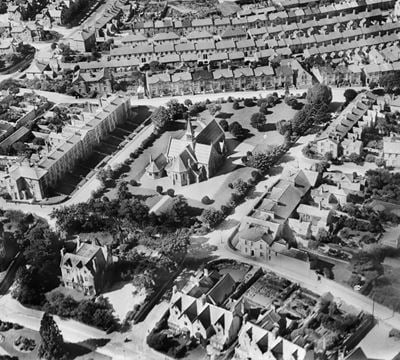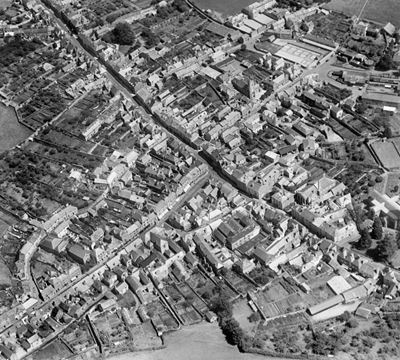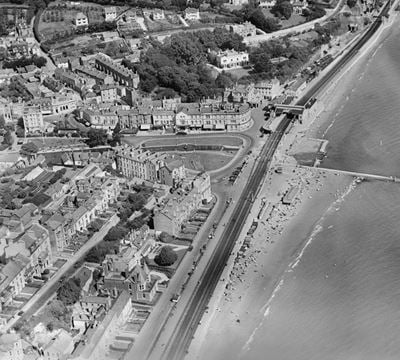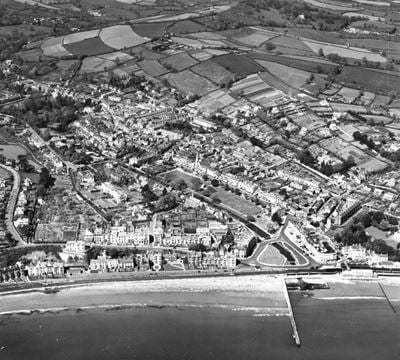Historic Teignbridge
Explore hidden histories, historic photos, and things you never knew about Teignbridge from the collections and archives of Historic England.
Discover Teignbridge's listed buildings and places
Introducing some of Teignbridge's most significant historic sites, curated from the National Heritage List for England. Skip this section and go to place by numbers
Castle Dyke
Ashcombe
Slight univallate hillforts are defined as enclosures of various shapes, generally between 1ha and 10ha in size, situated on or close to hilltops and defined by a single line of earthworks,...
Luscombe Castle
Dawlish
Luscombe Castle is a significant early 19th-century estate designed by John Nash and landscaped by Humphry Repton, known for its picturesque style and historical gardens.
Roman signal station 450m north of Marshall Farm
Ide
Roman signal stations were rectangular towers of stone or wood situated within ditched, embanked, palisaded or walled enclosures.
Dawlish Railway Station
Dawlish
A railway station, opened in 1875, built in an Italianate style for South Devon Railway, on the site of an earlier station building destroyed by fire.
Milber Down camp
Coffinswell
Small multivallate hillforts are defined as fortified enclosures of varying shape, located on hilltops.
Haytor granite tramway
Ilsington
Dartmoor is the largest expanse of open moorland in southern Britain and, because of exceptional conditions of preservation, it is also one of the most complete examples of an upland relict...
Bennett's Cross: a wayside cross on the south side of the…
Chagford
Wayside crosses are one of several types of Christian cross erected during the medieval period, mostly from the 9th to 15th centuries AD.
Bishop's Palace, Bishopsteignton
Bishopsteignton
Bishops' palaces were high status domestic residences providing luxury accommodation for the bishops and lodgings for their large retinues; although some were little more than country...
Kingskerswell Manor House
Kingskerswell
Medieval manorial settlements, comprising small groups of houses with associated gardens, yards and paddocks, supported communities devoted primarily to agriculture, and acted as the foci...
Denbury camp
Denbury and Torbryan
Large univallate hillforts are defined as fortified enclosures of varying shape, located on hilltops and surrounded by a single boundary comprising earthworks of large proportions.
Prehistoric and medieval settlements and their field syst…
Manaton
Medieval rural settlements in England were marked by great regional diversity in form, size and type, and the protection of their archaeological remains needs to take these differences into...
Grimspound, a partially enclosed prehistoric settlement w…
Manaton
Dartmoor is the largest expanse of open moorland in southern Britain and, because of exceptional conditions of preservation, it is also one of the most complete examples of an upland relict...
Churchyard Cross
Ipplepen
A standing cross is a free standing upright structure, usually of stone, mostly erected during the medieval period (mid 10th to mid 16th centuries AD).
Newton Abbot War Memorial, including the surrounding step…
Newton Abbot
War memorial, erected between 1920-22, added to after the Second World War and again following later conflicts, surrounded by a stepped base and decorative railings.
Cranbrook Castle
Moretonhampstead
Slight univallate hillforts are defined as enclosures of various shapes, generally between 1ha and 10ha in size, situated on or close to hilltops and defined by a single line of earthworks,...
Hunter's Tor camp
Lustleigh
Small multivallate hillforts are defined as fortified enclosures of varying shape, generally between 1 and 5ha in size and located on hilltops.
Wooston Castle
Moretonhampstead
Slight univallate hillforts are defined as enclosures of various shapes, generally between 1ha and 10ha in size, situated on or close to hilltops and defined by a single line of earthworks,...
13 Weech Road and former gig house
Dawlish
House and associated stable and gig or coach houseThe house is probably late C17 or early C18 with a transverse wing and two storey lean-to service range on the north side of 1846.
Church of St Winifred
Manaton
The Church of St Winifred in Manaton features a mix of 15th-century and later architectural elements, including richly carved timber screens and an ornate reredos.
Church of St Andrew
Kenn
The Church of St Andrew in Kenn features medieval architecture with significant 19th-century restorations. Notable elements include a 13-bay rood screen, C12 font, and vibrant stained glass.
1, 2, 2a and 2b, Bank Street, 5 and 5a, Somerset Place
Teignmouth
Three houses with shops on a corner site with offices above. Mid-C19. Read the official list entry to find out more.
Canonteign Barton
Christow
Canonteign Barton is a historic manor house dating back to the late 16th century, notable for its restoration in the 1970s and connection to the Davy family and Lord Viscount Exmouth.
Church of St John the Baptist
Ashton
The Church of St John the Baptist is noted for its medieval Perpendicular architecture and remarkable stained glass, paintings, and woodwork reflecting significant historical and familial...
Fingle Bridge
Drewsteignton
A C17 road bridge over the River Teign spanning the civil parish boundaries of Moretonhampstead and Drewsteignton at this popular picturesque location.
Chudleigh War Memorial
Chudleigh
First World War memorial, erected in 1926, with a Second World War dedication added in 1948Not included are the late-C20 railings and late-C20 stone planters.
Highweek War Memorial
Newton Abbot
War Memorial dedicated to the local men who lost their lives whilst serving their country in the First World War (1914-1918), with subsequent dedications to those Fallen in the Second World...
Ugbrooke Park
Chudleigh
Ugbrooke Park, remodeled by Robert Adam in the 18th century, is historically significant for its connection to the Clifford family and distinctive castellated design.
Church of St Bartholomew
Ogwell
The Church of St Bartholomew is a historic parish church from the 13th century, featuring extensive restorations, iconic nave and chancel, and important monuments of the Reynell family.
Chapel E of parish church
Buckfastleigh
A medieval chapel is a building, usually rectangular, containing a range of furnishings and fittings appropriate for Christian worship in the pre-Reformation period.
Church of St John the Baptist
North Bovey
The Church of St John the Baptist in North Bovey features elements from the 13th and 15th centuries, with significant restorations in the late 19th and early 20th centuries.
Kenn War Memorial
Kenn
A First World War memorial, dating from 1921, altered following the Second World War. Read the official list entry to find out more.
Mamhead War Memorial
Mamhead
A First World War memorial, erected 1926. Read the official list entry to find out more.
Three Headland Warren boundary stones, 350m, 330m and 400…
North Bovey
Dartmoor is the largest expanse of open moorland in southern Britain and, because of exceptional conditions of preservation, it is also one of the most complete examples of upland relict...
Headland Warren boundary stone 570m NNE of Headland Warre…
North Bovey
Dartmoor is the largest expanse of open moorland in southern Britain and, because of exceptional conditions of preservation, it is also one of the most complete examples of upland relict...
Two Headland Warren boundary stones, 275m and 430m north …
North Bovey
Dartmoor is the largest expanse of open moorland in southern Britain and, because of exceptional conditions of preservation, it is also one of the most complete examples of upland relict...
Tinworks, field systems, settlements, warren, cairns and …
Chagford
Dartmoor is the largest expanse of open moorland in southern Britain and, because of exceptional conditions of preservation, it is also one of the most complete examples of upland relict...
Medieval strip field system, tinworks, part of a prehisto…
Manaton
Dartmoor is the largest expanse of open moorland in southern Britain and, because of exceptional conditions of preservation, it is also one of the most complete examples of an upland relict...
Four round barrows on Soussons Down, 960m north west of S…
Manaton
Dartmoor is the largest expanse of open moorland in southern Britain and, because of exceptional conditions of preservation, it is also one of the most complete examples of an upland relict...
Explore more
See more listed placesHistoric Teignbridge through time
The National Heritage List for England contains hundreds of details about buildings and places, including the periods in which they were built and the uses they've had over the years. Explore how your local area has changed through time. Skip this section and go to aerial photos
Prehistoric Before AD 43
Prehistory covers a million years of human occupation before the Roman invasion and the introduction of writing. Primarily hunter-gatherers of several human species including Neanderthals, the peoples moved across Europe, hunting animals, exchanging ideas and developing complex culture and belief systems including burial rites and astronomical understanding, as at Stonehenge for example.
Roman AD 43 to AD 410
Britain was invaded by four legions of the Roman army in AD 43, who relatively rapidly conquered England from landing points in Kent. Parts of Wales and Scotland soon followed.
Roman culture brought urbanism, monumental buildings, wide-ranging religious beliefs, writing, and strong social hierarchy. The Roman administrative system was withdrawn in AD 410.
Early medieval AD 410 to AD 1066
This period, often associated in England with Anglo-Saxons and Vikings, saw a reduction in urban living from the Roman period and increased migration from northern Europe.
Traces of this period can be found in cemeteries, particularly in artefacts and in some of the very early churches, as this period also saw the growth of Christianity in Britain.
Medieval AD 1066 to AD 1540
This period, sometimes known as the Middle Ages, began with the Norman invasion in AD 1066. It saw a significant rise in military and defensive buildings such as castles and earthworks, as well as religious houses dominating a largely agricultural landscape.
The monarchy and Church dominated the period, which also saw the break with the Roman Church and the English reformation.
Post medieval AD 1540 to AD 1901
The Post-Medieval period brought seismic changes to life in England, with religious reformation leading to the democratization of worship and the destruction of hundreds of religious houses.
In parallel, there was a huge expansion of scientific study and enlightenment that permanantly altered the nation's social structure and landscape. Industrialization and mass production lead to wider global trade, emigration, and immigration.
20th century AD 1901 to AD 2000
The 20th century saw an incredible expansion of England's transport networks, with suburban growth shadowing rapid infrastructural expansion. The establishment of state schools, hospitals, and modern technical colleges, with new architectural styles, radically changed the appearance of towns and cities.
Two catastrophic world wars and the 1918 pandemic also brought unprecedented change, altering England's built environment and social structures forever.
Prehistoric Before AD 43
Prehistory covers a million years of human occupation before the Roman invasion and the introduction of writing. Primarily hunter-gatherers of several human species including Neanderthals, the peoples moved across Europe, hunting animals, exchanging ideas and developing complex culture and belief systems including burial rites and astronomical understanding, as at Stonehenge for example.
Roman AD 43 to AD 410
Britain was invaded by four legions of the Roman army in AD 43, who relatively rapidly conquered England from landing points in Kent. Parts of Wales and Scotland soon followed.
Roman culture brought urbanism, monumental buildings, wide-ranging religious beliefs, writing, and strong social hierarchy. The Roman administrative system was withdrawn in AD 410.
Early medieval AD 410 to AD 1066
This period, often associated in England with Anglo-Saxons and Vikings, saw a reduction in urban living from the Roman period and increased migration from northern Europe.
Traces of this period can be found in cemeteries, particularly in artefacts and in some of the very early churches, as this period also saw the growth of Christianity in Britain.
Medieval AD 1066 to AD 1540
This period, sometimes known as the Middle Ages, began with the Norman invasion in AD 1066. It saw a significant rise in military and defensive buildings such as castles and earthworks, as well as religious houses dominating a largely agricultural landscape.
The monarchy and Church dominated the period, which also saw the break with the Roman Church and the English reformation.
Post medieval AD 1540 to AD 1901
The Post-Medieval period brought seismic changes to life in England, with religious reformation leading to the democratization of worship and the destruction of hundreds of religious houses.
In parallel, there was a huge expansion of scientific study and enlightenment that permanantly altered the nation's social structure and landscape. Industrialization and mass production lead to wider global trade, emigration, and immigration.
20th century AD 1901 to AD 2000
The 20th century saw an incredible expansion of England's transport networks, with suburban growth shadowing rapid infrastructural expansion. The establishment of state schools, hospitals, and modern technical colleges, with new architectural styles, radically changed the appearance of towns and cities.
Two catastrophic world wars and the 1918 pandemic also brought unprecedented change, altering England's built environment and social structures forever.
Aerial photos of Teignbridge
Historic aerial photography shows the growth and changes in England's urban and rural landscapes, revealing secrets that are impossible to see from the ground. Skip this section and go to archive images

Newton Abbot
St Paul's Church, Newton Abbot, 1928

Newton Abbot
Courtenay Park and the town centre, Newton Abbot, 1932

Powderham
Powderham Castle, Powderham, 1930

Powderham
Powderham Castle, Powderham, 1948

Teignmouth
Courtenay Place, The Den and environs, Teignmouth, 1928

Teignmouth
The Den, Teignmouth Pier and the town, Teignmouth, 1932

Ashburton
The Bull Ring and environs, Ashburton, 1930

Ashburton
East Street and St Andrew's Church, Ashburton, 1932

Dawlish
Marine Parade and York Gardens, Dawlish, 1928

Dawlish
The town, Dawlish, 1948
Historic England Archive images of Teignbridge
The Historic England Archive holds and cares for over 15 million images, from the 1850s to the present day. Discover stunning images of Teignbridge's past. Skip this section and go to stories about heritage
Charles George Harper Collection
Teignbridge, Devon
Date created: 1892 - 1933
Looking up towards The Ness from the beach at Shaldon, with rowing boats on the sand in the foreground
Eileen ‘Dusty’ Deste Collection
Teignbridge, Devon
Date created: 1967
Ouldsbroom Cross at the junction of the B3357 and the lane to Ponsworthy
Eric de Mare
Devon
Date created: 1945 - 1980
General view of an unidentified thatched cottage in Devon.
John Gay Collection: Rural Life
Devon
Date created: 1955 - 1965
A view of a stream running through a lightly wooded area, with a fern growing on a bank in the foreground.
John Gay Collection: Counties
Bickington, Teignbridge, Devon
Date created: Apr 1958
A view over a thatched cottage with tapered chimneys to the upper stage of the Church of St Mary the Virgin, Bickington, showings its turret,...
London, Midland and Scottish Railway Company
Kenton, Teignbridge, Devon
Date created: 10 Jul 1911 - 14 Jul 1911
The interior of the nave of All Saints' Church, looking east towards the rood screen
Nigel Temple Collection of Postcards of Parks and Gardens
Dart Bridge, Teignbridge, Devon
Date created: 1939 - 1950
EXTERIOR VIEW FROM THE TEA GARDEN
Margaret Tomlinson Collection
Teignbridge, Devon
Date created: Aug 1944 - Dec 1944
A view looking east from the tower of Holy Trinity Church towards the chapel ruins at the far end of the graveyard
Alfred Newton and Sons
Teignbridge, Devon
Date created: 1896 - 1920
GENERAL VIEW LOOKING TOWARDS IPPLEPEN FROM PARK HILL
Nigel Temple Collection of Postcards of Parks and Gardens
Teignbridge, Devon
Date created: 1930 - 1960
EXTERIOR VIEW FROM THE TEA GARDEN
Margaret Tomlinson Collection
Teignbridge, Devon
Date created: Aug 1944 - Aug 1945
A view from Dart Bridge showing Dartbridge Cottage Toll House and the A384 Totnes Road
Stories about heritage in Teignbridge
Historic England publishes news, blogs, videos and podcasts celebrating England's heritage. Discover the stories we have about Teignbridge. Skip this section and go to education
What Is the Oldest Building in England?
Mentions Grimspound, a partially enclosed prehistoric settlement with field system and two post-medieval caches between Hookney Tor and Hameldown Tor
From the oldest church to archaeological remains, here are the contenders for England's oldest building.
The Buildings of Philanthropist John Passmore Edwards
Mentions Adult Education Centre and Library
Over 70 buildings were constructed in 14 years, including libraries, literary institutes and art galleries.
Famous Faces From TV and Radio Uncover More About England’s Heritage
Mentions Powderham Castle
A series of short films featuring some of the fascinating people and places helped by grants from the Culture Recovery Fund during the pandemic.
Explore your social history through photos
Over 10,000 images from the Historic England Archive have been specially selected and re-captioned for teachers, students, and anyone who wants to learn more about heritage in their local area. Skip this section and go to grant-aided places
The Yacht Pond, Dawlish, Devon
Period: 1940s (1946 - 1949)
A view showing children beside the yacht pond.
The Old Mill, Station Road, Bovey Tracey, Devon
Period: Victorian (1837 - 1901)
The building was never used as a mill but was built in 1854 as a stable to Bridge House which is now the Riverside Inn.
The Old Mill, Station Road, Bovey Tracey, Devon
Tags
The Beach, Dawlish, Devon
Period: Victorian (1837 - 1901)
An elevated view looking north-east along the beach at Dawlish. The houses of the town lie to the left.
The Beach, Dawlish, Devon
Starcross Pumping House, The Strand, Starcross, Devon
Period: Victorian (1837 - 1901)
The pumping house was built in 1845. It was designed by Isambard Kingdom Brunel in an Italianate style. It contained boilers and a massive beam engine.
Starcross Pumping House, The Strand, Starcross, Devon
Tags
St Michael's Cottages, Ilsington, Devon
Period: Tudor (1485 - 1602)
This row of 3 cottages dates from the early 16th century and was formerly the church house.
St Michael's Cottages, Ilsington, Devon
St Mary's Church, Denbury, Devon
Period: Victorian (1837 - 1901)
St Mary's Church, Denbury.
St Augustine's Priory, Priory Road, Newton Abbot, Devon
Period: Georgian (1714 - 1836)
St Augustine's Priory was built in the early 19th century as a house. It was remodelled and extended as a priory in 1861.
St Augustine's Priory, Priory Road, Newton Abbot, Devon
Row of 4 cottages, Chapel Street, Buckfastleigh, Devon
Period: Stuart (1603 - 1713)
This row of 4 cottages has a tenter loft, for drying cloth, on the upper storey. The cottages date from the late 17th or early 18th century.


